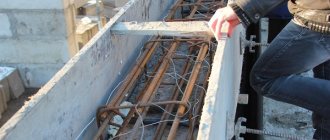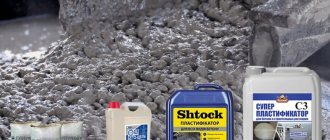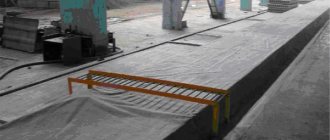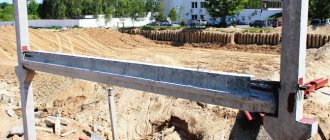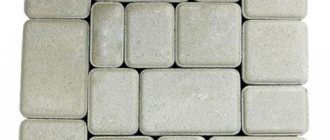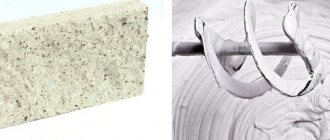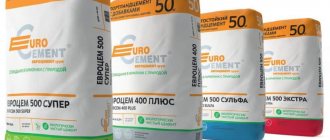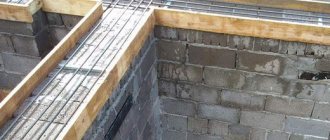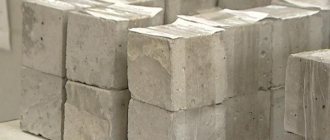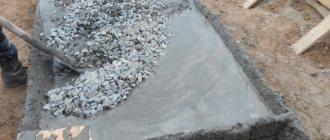Beton-House.com
Website about concrete: construction, characteristics, design. We combine the experience of professionals and private craftsmen in one place
Structure of heavy concrete of the test sample
The design compressive strength of concrete is one of the key characteristics that must be taken into account when designing any structure made from this material, and at the beginning of any construction. At the same time, it is necessary to pay attention to it not only to professionals, but also to ordinary craftsmen who have decided to build a house with their own hands.
- What determines the strength of concrete?
Design strength
Design strength (grade) is the standardized strength of concrete at the age of 28 days or at other times, allowing the transfer of the full design load to the product. If the design documentation, GOST or technical specifications for the product do not indicate the period for concrete to reach the design grade, then this period should be considered 28 days from the date of manufacture.
The average values of the coefficients of increase in strength of concrete using cements of various types, hardening in the open air at positive temperatures at the age of 90 and 180 days, are given in Table. 5.
Concepts of strength and class
Strength by grade was used before the introduction of European standards, and it designated average compressive strength. New SNiPs regulate classes of compressive-tensile strength.
Increase in strength
[ads-pc-1] [ads-mob-3]
The concept of “class” means the resistance of the material, according to SP, to the axial compression of a concrete cube. The reference dimensions of the cube are 15 x 15 cm. Due to the uneven distribution of strength parameters throughout the material, the use of arithmetic average strength indicators is not recommended, since in a local area the objective strength may be lower.
The main characteristic of the service life of a concrete object is its class. When determining the class, both axial compression and axial tension are taken into account, the values of which are determined with a safety margin through the resistivity of the elements.
Maximum permissible stress
Formula for determining resistance to compression loads: R = Rn /g;
Where g is the strength coefficient of the material, taken as 1.0. The more homogeneous the concrete, the closer the g coefficient is to unity.
Additional parameters for calculations:
- Electrical resistivity of the solution;
- Moisture resistance - its parameters are necessary to know the maximum pressure of the liquid medium that concrete can withstand;
- Air permeability is related to strength, and has a constant value in the range of 3-130 c/cm3.
- Frost resistance is indicated by the symbol “F” and numbers from 50 to 1000, indicating the number of freeze-thaw cycles;
- Thermal conductivity affects the density of the material. The more air in concrete, the lower the density and thermal conductivity;
Visual detection of cracks in samples
[ads-pc-1] [ads-mob-3]
Longitudinal cracks in the tested prismatic samples appear under the influence of transverse loads. The strength of the sample increases when the concrete is tightened with clamps, but destruction will occur in any case, and cracks will appear later. This postponement of destruction in time is called the clip effect. The clamp, the compression element, can be replaced by placing transverse rod reinforcement, metal mesh or a steel spiral in the solution.
- The brand is designated by the symbol “M”, and means the average cubic strength Rв, which is expressed in kg/cm2. The numbers following the Latin letter are strength;
- Class – symbol “B”, indicating cubic strength (MPa) with a probability of 0.95. The heterogeneity of the strength of the material fluctuates within the range Rmin-Rmax.
Transfer strength
Transfer strength is the standardized strength of concrete of prestressed products at the moment the pre-tensioning reinforcement is transferred to it.
The value of the transfer strength of concrete is regulated by the project, GOST or TU for this type of product.
The transfer strength of concrete is assigned to not less than 70% of the design grade, which is usually accepted for prestressed products, depending on the type and class of prestressed reinforcement; in this case, the actual value of the transfer strength, taking into account the requirements of statistical control in production, must be at least 14 MPa, and for bar reinforcement of class Αt-VI, reinforcing ropes and wire reinforcement without intermediate heads - at least 20 MPa.
| Properties of concrete | Designations | Unit _ | Conversion formula (ratio) |
| Prismatic strength | RPr | MPa | |
| Axial tensile strength | RP | MPa | |
| Bending tensile strength | RР. And | MPa | |
| Initial modulus of elasticity | EB | MPa | |
| Shear modulus | G6 | MPa | |
| Strength of adhesion to reinforcement Fatigue limit | RSc | MPa MPa | |
| Shear strength (chipping) | RCp | MPa | |
| Crushing strength | RCm | MPa | I |
| Coefficient of linear expansion when heated from 0 to 100°C | α | Grad-1 | |
| Concrete shrinkage (ultimate compressibility) | Mmm | 0,2 – 0,4 | |
| The same, reinforced | Mmm | 0,15 | |
| Creep characteristic | φ+ | — | |
| Ultimate elongation | Mmm | 0,1—2 | |
| Coefficient of thermal conductivity | λ | W/(m.k) | λ ≈ 1.4 |
| Abrasion | AND | G/cm2 | I = 0.01 – 0.1 |
The main characteristics and physical properties of heavy concrete are given in table. 4.
Definitions
Strength is the main quality that accurately describes its load-bearing capacity. It is determined by the compression limit - this is the highest load limit at which failure of the sample occurs. And this is the main indicator that is taken into account when using it.
Design resistance is an indicator of a material’s resistance to loading influences. It is used in design calculations, and is integrally related to standard indicators of compression resistance.
Until the 2000s, they focused only on grades of material, which were taken as a design indicator, but according to new technical documents, each grade was assigned a new criterion for the sample’s compliance with compressive loads.
It was identified in laboratory conditions, legalized by specialists and reflected in SP 52−101−2003. According to this technical document, the standard resistance of a material to axial compression is the compression class specified with 95% certainty. The condition means that it is met in 95% of tested cases, and only in 5% can it deviate from the established indicators.
But even this percentage proves that using average calculated indicators when designing is unjustifiably risky. And when choosing the smallest value, the cross-section of the structure or product will increase, which in turn will affect the overexpenditure of money and energy resources.
According to SP 52−101−2003, standard resistance values are presented in the photo below.
Standard and calculated resistance values
There is also such a definition as tensile strength. By its nature, this material can withstand tensile loads much worse. That’s why it is reinforced in reinforced concrete products, thick floor screeds, foundations, etc.
When calculating, the compression indicator is used as a priority. In principle, any product or structure experiences heavy loads precisely from compressive static or dynamic influences. But resistance to bending influences is taken into account during design. In such cases, simply use the class correspondence table.
Table 6.7 from SP 63.13330.2012 SNiP 52-01-2003, which indicates the grades of resistance to compression and tension.
| View | Concrete | Standard resistances MPa, and calculated resistances for limit states of the second group and MPa, with a material class according to compressive strength | |||||||||||||||||||||
| B1.5 | AT 2 | B2.5 | B3.5 | AT 5 | B7.5 | AT 10 | B12.5 | B15 | IN 20 | B25 | B30 | B35 | B40 | B45 | B50 | B55 | B60 | B70 | B80 | B90 | B100 | ||
| Compression axial tension | Heavy, fine-grained and straining | — | — | — | 2,7 | 3,5 | 5,5 | 7,5 | 9,5 | 11 | 15 | 18,5 | 22 | 25,5 | 29 | 32 | 36 | 39,5 | 43 | 50 | 57 | 64 | 71 |
| Easy | — | — | 1,9 | 2,7 | 3,5 | 5,5 | 7,5 | 9,5 | 11 | 15 | 18,5 | 22 | 25,5 | 29 | — | — | — | — | — | — | — | — | |
| Cellular | 1,4 | 1,9 | 2,4 | 3,3 | 4,6 | 6,9 | 9,0 | 10,5 | 11,5 | — | — | — | — | — | — | — | — | — | — | — | — | — | |
| Axial tension | Heavy, fine-grained and straining | — | — | — | 0,39 | 0,55 | 0,70 | 0,85 | 1,00 | 1,10 | 1,35 | 1,55 | 1,75 | 1,95 | 2,10 | 2,25 | 2,45 | 2,60 | 2,75 | 3,00 | 3,30 | 3,60 | 3,80 |
| Easy | — | — | 0,29 | 0,39 | 0,55 | 0,70 | 0,85 | 1,00 | 1,10 | 1,35 | 1,55 | 1,75 | 1,95 | 2,10 | — | — | — | — | — | — | — | — | |
| Cellular | 0,22 | 0,26 | 0,31 | 0,41 | 0,55 | 0,63 | 0,89 | 1,00 | 1,05 | — | — | — | — | — | — | — | — | — | — | — | — | ||
The shear strength during chipping determines the resistance to compression and correlation indicators.
Note. Compression resistance B25 is the most commonly used indicator when designing a material.
Reinforcement for heavy concrete
| Type and class of prestressed reinforcement | The design grade of concrete is not lower than |
| Wire reinforcement classes: | |
| BH with anchors | 250 |
| Bp-II without anchors with wire diameter: up to 5 mm inclusive | 250 |
| 6 mm or more K-7 (GOST 13840-68 *) | 400 |
| K-19 (TU 14-4-22-71 *) | 350 |
| From 10 to 18 mm (inclusive) classes: | |
| A-IV and Αt-IV | 200 |
| AV and Αt-V | 250 |
| Αt-VI | 350 |
| 20 mm and more classes: | |
| A-IV and Αt-IV | 250 |
| AV and Αt-V | 350 |
| Αt-VI | 400 |
Table 5
| Type and mineralogical composition of cement | K coefficient value, day | |
| 90 | 180 | |
| Aluminate Portland cement (C3 A ≥ 12%) | 1,05 | 1.1 |
| Alite Portland cement (C3 S ≥ 50%; C3 A ≤ 8%) | 1,05 | 1,1 |
| Pozzolanic Portland cement, Portland slag cement with slag content up to 40% | 1,05 | 1,25 |
| Belite Portland cement and slag Portland cement with a slag content of more than 50% | 1,1 | 1,3 |
Note. The values of K can be determined by the formula K = log / log28 for n > 3, where
P – age of concrete in days. The data obtained can be used for approximate calculations of concrete composition. In this case, the strength of concrete aged n days (RN) is determined by the formula RN = R28 • K.
If the design grade of concrete is accepted above the specified minimum value, then the transfer strength must be at least 50% of the adopted design grade.
What is Design Resistance
This parameter can be found out and calculated by simply dividing the resistances specified in GOST 12730.0-78 by reliability, which is reflected in the form of a certain coefficient. When calculating the resistance of concrete, this coefficient depends on the type of building material.
Graph of tensile strength along the axes
[ads-pc-1] [ads-mob-2]
The values of the calculated resistances of materials are designated as Rb and Rbt, their indicators can be changed towards decreasing or increasing by multiplying by the concrete operating condition coefficient γbi, which reflects the proportionality of the values depending on the time of application of the load; cyclical loading; parameters, properties and time period of operation of the structure; manufacturing method; section, area, etc. You can find out the specific calculated compressive strength of concrete, the table of values of which reflects mathematical calculations rather than physical data, for classes in demand by industry:
| Resistance, type | Type | Calculated indicators for the maximum loaded states of the 1st group Rb and Rbt, MPa, for different strength classes | ||||||
| B 10 | B 12.5 | B 15 | B 20 | B 25 | B 30 | B 35 | ||
| Axial compression, Rb | Fine-grained heavy concrete | 6,0 | 7,50 | 8,5 | 11,5 | 14,50 | 17,0 | 19,50 |
| Axial stretch, RM | Heavy concrete | 0,57 | 0,66 | 0,75 | 0,90 | 1,050 | 1,20 | 1,30 |
How is strength calculated? There are certain strength values that are lowered to ensure reliability. These established parameters are calculated indicators, depending on the actual test results.
Tempering strength
Release strength is the standard strength of concrete at which the product is allowed to be shipped from the factory to the consumer.
The value of the tempering strength of concrete products is regulated by GOST for this type of product, and in the absence of GOST or if the value of the tempering strength is not regulated by GOST, it is established by the manufacturer in agreement with the consumer and the design organization.
The value of the tempering strength is determined taking into account the conditions of transportation, installation and the period of load transfer to the products, as well as taking into account the technology of their manufacture and the possibility of further increasing the strength of concrete in the products, depending on the climatic conditions of the construction area and the time of year.
In this case, the value of the tempering strength of concrete as a percentage of its design grade for compressive strength must be no less than the grade given below; it is allowed only in cases where loads close to the design ones can be tolerated during transportation and installation of the product; in the cold season, if conditions cannot be created for an increase in the strength of concrete before the design load is transferred to the product.
| Concrete in products | Tempering strength, percent. from the design brand, no less |
| Heavy concrete and concrete with porous aggregates | |
| M150 and above | 50 |
| Heavy concrete M100 and below | 70 |
| Concrete on porous aggregates Ml00 and below | 80 |
| Concrete of all types and grades, produced with autoclave processing.... | 100 |
Strength control methods
Methods for determining strength are divided into destructive and non-destructive.
Destructive methods include testing samples made from BSG and samples taken from structures under static loading at a constant rate of load increase using special presses, followed by calculation of stresses at the resulting minimum forces that destroy the sample. Those. destructive testing methods lead to complete destruction of the test object (cube, core, etc.). Determination of concrete strength using control samples made from concrete mixture in accordance with GOST 10180. Determination of concrete strength using core samples taken from structures in accordance with GOST 28570.
Non-destructive methods include methods for testing the strength of concrete, incl. mechanical, direct and indirect, carried out on samples and building structures that do not lead to the complete destruction of the sample or to the loss of load-bearing capacity and serviceability of the tested building structure.
Direct non-destructive methods of strength testing include methods that provide standard test schemes and allow the use of known calibration dependencies without reference or adjustment.
Direct non-destructive methods for testing the strength of concrete are the “tearing with spallation” and the “rib shearing method” within the boundaries of the standard test scheme established by GOST 22690. The tearing with shearing method is based on the connection between the strength of concrete and the value of the force of local destruction of concrete when an anchor device is pulled out of it. The rib shearing method is based on the relationship between the strength of concrete and the force required to shear off a section of concrete on the rib of a structure.
To indirect non-destructive methods of testing the strength of concrete, not
which are direct methods, include tests based on measuring the value of an indirect characteristic, which depends on the strength of concrete, as well as on other properties of concrete, which leads to the need to establish a calibration relationship for a specific type of concrete and its nominal composition.
Indirect non-destructive methods for testing the strength of concrete are mechanical methods established by GOST 22690, such as the method of elastic rebound, plastic deformation, shock impulse, as well as the ultrasonic method established by GOST 17624. Indirect mechanical methods of strength testing are based on the relationship between the strength of concrete and determined under local mechanical influence indirect characteristics of strength - change in impact energy, imprint size, rebound value. The ultrasonic method is based on the relationship between the strength of concrete and the speed or time of propagation of ultrasound in it.
